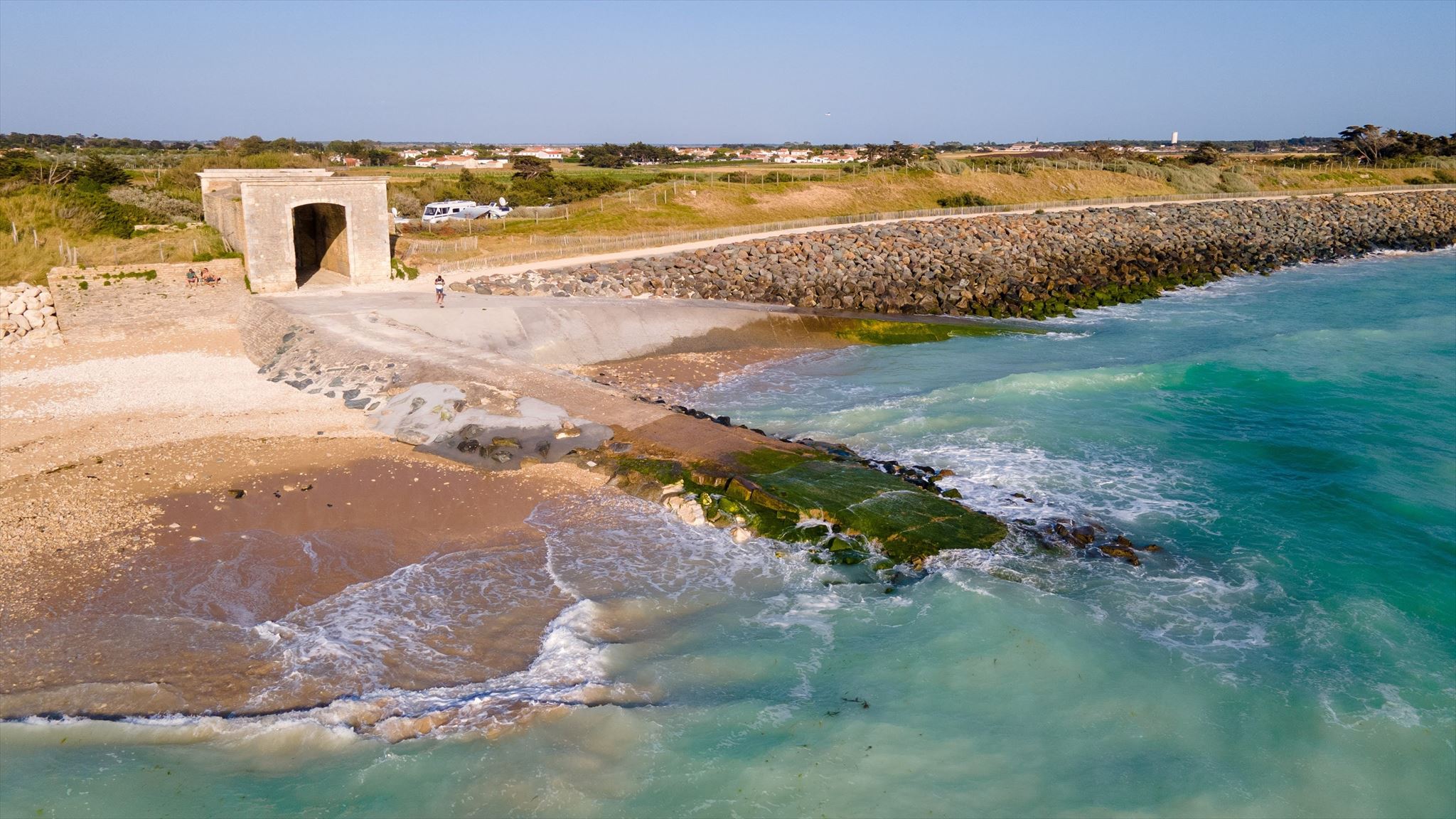
Vous voici devant l'abri du canot de sauvetage construit en 1867, il n'y a que 155 ans .
Imaginez le coup de canon, les agriculteurs abandonnant tout pour s'embarquer et partir en sauvetage d'un naufrage ... c'était une sacrée époque !

D'ici, vous pouvez voir trois systèmes de protection construits par l'homme pour la navigation maritime :
-L'abri du canot de sauvetage,1867 (lire la panneau juste avant de passer sous l'abri)
-Le phare des Baleines, allumé en 1854, où il faut absolument aller même si c'est un lieu un peu trop fréquenté en été ...
-Le sémaphore construit sur le site de La tour Chappe des Baleines, érigée en 1863. Elle était constituée d’un seul étage, au sommet duquel on transmettait les signaux, et fut ensuite surélevée par le poste de surveillance que nous connaissons aujourd’hui. Le système télégraphique équipa ensuite le sémaphore pour une communication plus étendue. Sur le linteau de la porte d’entrée du sémaphore des Baleines on peut d’ailleurs lire : « poste de télégraphe public » puisqu’à cette époque la population pouvait venir y passer ses communications.
On compte 59 sémaphores sur tout le pays dont 26 sur le littoral atlantique. Celui des Baleines est un sémaphore de seconde catégorie, ce qui signifie qu’il observe une veille du lever au coucher du soleil et est encadré des sémaphores de Chassiron et de Saint-Sauveur (île d’Yeu) qui sont des sémaphores de première catégorie. Durant les périodes nocturnes, ces derniers prennent la main sur les instruments des Baleines pour en assurer la veille.
Les instruments de surveillance de base restent les jumelles et l’écho-radar mais les militaires et marins, spécialement formés à la discipline que sont les guetteurs de la Flotte, disposent aujourd’hui de matériel technique de pointe avec le logiciel Spationav (contrôle AIS, système d’identification automatique des navires, couplé sur l’écho radar), la VHF traditionnelle, la VHF ASN (Appel sélectif numérique) la radio gonio, sans parler de l’anémomètre ou de matériel plus simple mais non moins efficace tels le pluviomètre manuel ou le phare pour les communications en SCOTT (transmission de donnés par signaux lumineux), sorte de code Morse optique.
Validation de la cache :
Pour valider cette cache, vous devrez prouver votre présence aux coordonnées en joignant à votre log, une photo que vous prendrez de manière à avoir dans le cadrage: le Phare, le sémaphore et l'abri. Vous devez inclure votre pseudo géocaching, en prenant la photo, en l'écrivant sur un papier, votre main ou le téléphone.. Ajouter le pseudo à postérioiri n'est pas accepté.
Tout log non conforme sera supprimé, désolée...

Here you are in front of the lifeboat shelter built in 1867, only 155 years ago.
Imagine the cannon shot, farmers abandoning everything to embark and rescue from a shipwreck...it was a hell of a time!
From here you can see three man-made protection systems for marine navigation:
-The lifeboat shelter,1867 (read the sign just before going under the shelter)
-The Baleines lighthouse, lit in 1854, where you absolutely have to go even if it's a bit too crowded in summer...
-The semaphore built on the site of the Chappe des Baleines tower, erected in 1863. It consisted of a single floor, at the top of which signals were transmitted, and was then raised by the surveillance post that we know today . The telegraph system then equipped the semaphore for more extensive communication. On the lintel of the entrance door of the Baleines semaphore one can also read: "public telegraph station" since at that time the population could come to pass their communications there.
There are 59 semaphores throughout the country, including 26 on the Atlantic coast. That of the Whales is a second category semaphore, which means that it observes a watch from sunrise to sunset and is framed by the semaphores of Chassiron and Saint-Sauveur (Ile d'Yeu) which are first category semaphores . During the night periods, the latter take control of the instruments of the Whales to ensure the day before.
The basic surveillance instruments remain binoculars and echo-radar, but the soldiers and sailors, specially trained in the discipline of Fleet lookouts, now have state-of-the-art technical equipment with the Spationav software (AIS control , automatic ship identification system, coupled to the radar echo), traditional VHF, VHF DSC (digital selective calling), gonio radio, not to mention the anemometer or simpler but no less effective equipment such as the manual rain gauge or the headlight for communications in SCOTT (transmission of data by light signals), a kind of optical Morse code.
Validation of this virtual cache:
To validate this cache, you will have to prove your presence at the coordinates by attaching to your log, a photo that you will take in order to have: the Lighthouse, the semaphore and the shelter. You must include your geocaching nickname, by taking the photo, writing it on a paper, your hand or the phone. Adding the nickname afterwards is not accepted.
Any non-compliant log will be deleted, sorry...

Virtual Rewards 3.0 - 2022-2023
This Virtual Cache is part of a limited release of Virtuals created between March 1, 2022 and March 1, 2023. Only 4,000 cache owners were given the opportunity to hide a Virtual Cache. Learn more about Virtual Rewards 3.0 on the Geocaching Blog.